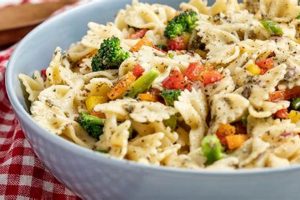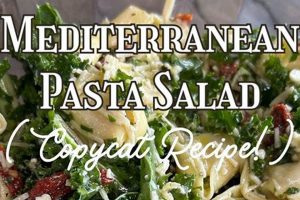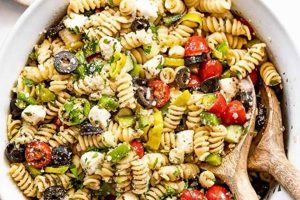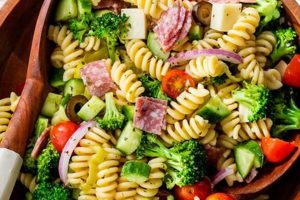A Mediterranean-inspired dish featuring pasta, typically rotini or orzo, combined with classic Greek ingredients such as feta cheese, Kalamata olives, cucumbers, tomatoes, red onion, and a lemon-herb vinaigrette. Variations may include other vegetables like bell peppers or artichoke hearts, as well as protein additions such as grilled chicken or chickpeas. A wide array of preparation methods and ingredient combinations exist, allowing for customization based on dietary needs and preferences.
This type of dish offers a refreshing and flavorful meal option, particularly suited for warmer weather. The combination of fresh vegetables, salty cheese, and tangy dressing provides a balanced nutritional profile, rich in vitamins, minerals, and healthy fats. Its versatility makes it suitable for potlucks, picnics, and light lunches or dinners. Historically, pasta salads emerged as a convenient and portable food, gaining popularity with the rise of refrigeration and readily available ingredients. The Greek variation draws inspiration from the Mediterranean diet, known for its health benefits and emphasis on fresh, seasonal produce.
This discussion will further explore specific ingredient selections, variations on the classic recipe, and tips for achieving optimal flavor and texture. Nutritional information and suggested pairings will also be provided.
Tips for Exceptional Pasta Salad
Optimizing ingredient selection and preparation techniques elevates this dish from simple to extraordinary. Attention to detail ensures a flavorful, visually appealing, and texturally satisfying culinary experience.
Tip 1: Pasta Selection: Opt for short, sturdy pasta shapes like rotini, orzo, or farfalle. These hold the dressing well and provide a pleasant mouthfeel. Avoid long, thin noodles, which can become tangled and difficult to manage.
Tip 2: Vegetable Freshness: Utilize peak-season produce for optimal flavor and texture. Crisp cucumbers, ripe tomatoes, and vibrant bell peppers contribute significantly to the overall quality.
Tip 3: Optimal Cheese: Authentic feta, preferably stored in brine, provides a tangy, salty counterpoint to the other ingredients. Crumble it into the salad rather than dicing for a more appealing presentation.
Tip 4: Dressing Emulsification: Whisk the dressing ingredients vigorously to create a stable emulsion. This prevents separation and ensures even coating of the pasta and vegetables.
Tip 5: Marination Time: Allow the salad to marinate for at least 30 minutes before serving. This allows the flavors to meld and the pasta to absorb the dressing, resulting in a more cohesive dish.
Tip 6: Herb Integration: Fresh herbs like oregano, mint, and dill enhance the Mediterranean profile. Add them just before serving to retain their vibrant aroma and flavor.
Tip 7: Temperature Control: Serve the salad chilled for optimal refreshment. Avoid leaving it at room temperature for extended periods to maintain food safety.
By following these guidelines, one can create a pasta salad that showcases the bright, fresh flavors of the Mediterranean. Attention to these details ensures a delightful and satisfying culinary experience.
This exploration concludes with a summary of key elements and suggestions for further culinary exploration.
1. Fresh Ingredients
The emphasis on fresh ingredients distinguishes authentic Greek pasta salad from other variations. Ingredient quality significantly impacts the overall flavor, texture, and nutritional value. Utilizing fresh produce elevates this dish from ordinary to exceptional.
- Ripe Tomatoes:
Ripe, juicy tomatoes provide sweetness and acidity, balancing the saltiness of the feta and olives. Locally sourced, in-season tomatoes offer superior flavor compared to out-of-season alternatives. The choice between cherry tomatoes, chopped Roma tomatoes, or larger heirloom varieties impacts both flavor and visual appeal.
- Crisp Cucumbers:
Cucumbers contribute a refreshing coolness and satisfying crunch. English cucumbers, known for their thin skin and minimal seeds, offer a refined texture. Peeling and seeding standard cucumbers before dicing can enhance their contribution to the salad.
- Fragrant Herbs:
Fresh herbs such as oregano, dill, and mint provide a burst of aromatic complexity. Incorporating these herbs just before serving preserves their delicate flavors and vibrant green color. Dried herbs can be substituted in a pinch, but the flavor profile will differ noticeably.
- Quality Feta:
Authentic feta cheese, traditionally made from sheep’s milk or a blend of sheep and goat milk, contributes a tangy, salty element crucial to the dish’s character. Storing feta in brine preserves its creamy texture and prevents it from drying out. Lower-quality feta substitutes often lack the characteristic flavor and texture of true feta.
The careful selection of fresh, high-quality ingredients elevates Greek pasta salad, creating a harmonious blend of flavors and textures. Prioritizing freshness ensures a vibrant, nutritious, and ultimately satisfying culinary experience.
2. Authentic Greek Flavors
Authentic Greek flavors constitute the essence of Greek pasta salad, differentiating it from other pasta salad variations. These flavors, derived from specific ingredients and their interplay, create a distinctive sensory experience essential for culinary authenticity. The omission or substitution of key components compromises the integrity of the dish, resulting in a departure from the traditional Greek profile.
Kalamata olives, with their robust, briny character, contribute a crucial salty and savory element. Feta cheese, particularly authentic Greek feta made from sheep’s or goat’s milk, provides a tangy, creamy counterpoint. The inclusion of fresh oregano, dill, and mint introduces a layer of herbal complexity characteristic of Mediterranean cuisine. Lemon juice and extra virgin olive oil, staples of the Greek pantry, contribute brightness and richness, respectively. The harmonious balance of these components defines the authentic Greek flavor profile. Deviation from these core ingredients, such as substituting black olives for Kalamata or using a different type of cheese, alters the fundamental taste and moves away from genuine Greek culinary tradition.
Understanding the specific contributions of these core ingredients allows for informed recipe adaptation while maintaining the integrity of the Greek flavor profile. For example, while variations might include other vegetables or protein additions, the foundational elements must remain consistent to preserve authenticity. Appreciation of these flavor dynamics allows for informed culinary choices, enabling cooks to create pasta salads that genuinely reflect the essence of Greek cuisine. Preserving the balance and integrity of these authentic flavors ensures a culinary experience that resonates with tradition and delivers the intended depth of flavor.
3. Varied Pasta Shapes
Pasta shape selection significantly influences the overall sensory experience of Greek pasta salad. Different shapes offer varying textures and interact differently with the dressing and other ingredients. Understanding the characteristics of various pasta types allows for informed choices that enhance the dish’s visual appeal, texture, and flavor absorption.
- Rotini:
The spirals of rotini effectively capture the dressing and ingredients within their curves, ensuring even distribution of flavor. Their sturdy structure holds up well in the salad, preventing breakage and maintaining a pleasant texture.
- Orzo:
Orzo’s rice-like shape offers a unique textural contrast to the other ingredients. Its small size allows it to absorb the dressing readily, resulting in a flavorful and cohesive salad. The delicate nature of orzo necessitates gentle mixing to avoid breakage.
- Farfalle:
Farfalle, or bow-tie pasta, adds visual interest and a playful element to the salad. Its ruffled edges provide ample surface area for capturing the dressing. While aesthetically pleasing, farfalle can be prone to clumping if not mixed carefully.
- Other Shapes:
While rotini, orzo, and farfalle are popular choices, other short, sturdy pasta shapes like penne, fusilli, or shells can also be incorporated successfully. The key consideration is selecting a shape that holds its form, absorbs the dressing well, and complements the other ingredients texturally.
The chosen pasta shape contributes not only to the aesthetic presentation but also to the overall culinary experience. Selecting a shape that complements the other ingredients and effectively carries the flavors of the dressing elevates the dish, demonstrating an attention to detail crucial for creating a truly satisfying Greek pasta salad.
4. Customizable Recipes
The inherent adaptability of Greek pasta salad recipes contributes significantly to their widespread appeal. Customization allows for adjustments based on dietary preferences, ingredient availability, and desired flavor profiles. This flexibility distinguishes Greek pasta salad as a versatile dish suitable for diverse culinary contexts. The core componentspasta, feta cheese, olives, and a vinaigretteprovide a foundational structure upon which numerous variations can be built. This adaptability fosters creativity and personalization, empowering individuals to tailor the recipe to specific needs and preferences.
Numerous examples demonstrate the practical application of this customizability. Vegetarian adaptations might incorporate chickpeas or white beans for added protein, while those seeking a heartier meal could include grilled chicken or shrimp. Ingredient swaps, such as sun-dried tomatoes for fresh or artichoke hearts for olives, offer further avenues for flavor exploration. Dietary restrictions can also be accommodated; gluten-free pasta allows individuals with sensitivities to enjoy the dish, while adjustments to the vinaigrette cater to those limiting sodium or fat intake. This adaptability ensures inclusivity and broadens the dish’s appeal across a wider range of culinary preferences and dietary needs.
Understanding the customizable nature of Greek pasta salad recipes empowers individuals to move beyond static instructions and engage with the dish creatively. This adaptability extends the dish’s relevance beyond specific recipes, transforming it into a versatile template for culinary expression. Recognizing this inherent flexibility encourages experimentation and personalizes the cooking experience, fostering greater appreciation for the dishs adaptable nature and its potential to satisfy diverse palates and dietary requirements.
5. Versatile Serving Options
The versatility of Greek pasta salad extends beyond its customizable nature to encompass a wide range of serving options. This adaptability contributes significantly to the dish’s popularity, making it suitable for diverse occasions and culinary contexts. Understanding these varied applications underscores the dish’s practical value and broad appeal.
- Standalone Meal:
Greek pasta salad functions effectively as a light yet satisfying standalone meal, particularly during warmer months. Its balanced composition of carbohydrates, protein (often from feta or optional additions like chickpeas or grilled chicken), and healthy fats provides nutritional completeness. This characteristic makes it a convenient and healthy option for lunch or a light dinner.
- Side Dish:
The refreshing flavors and vibrant colors of Greek pasta salad make it an ideal accompaniment to grilled meats, fish, or other main courses. Its lightness provides a counterpoint to richer dishes, creating a balanced and appealing meal. The salad’s Mediterranean character complements a variety of cuisines, extending its versatility beyond Greek-inspired menus.
- Potluck Contribution:
The ease of transport and room-temperature stability make Greek pasta salad a popular choice for potlucks, picnics, and other social gatherings. Its make-ahead nature allows for convenient preparation, while its visually appealing presentation enhances any buffet spread. The adaptability of the recipe allows cooks to adjust quantities easily to accommodate larger groups.
- Packed Lunch:
Greek pasta salad travels well, making it a convenient and healthy option for packed lunches. Its robust ingredients hold up well in transport, and it requires no heating, making it ideal for work or school settings. The customizable nature of the dish allows individuals to tailor it to their specific dietary needs and preferences.
The adaptability of Greek pasta salad to diverse serving scenarios contributes significantly to its enduring popularity. Whether enjoyed as a refreshing standalone meal, a complementary side dish, a convenient potluck contribution, or a portable packed lunch, its versatility makes it a valuable addition to any culinary repertoire. This adaptability reinforces the dish’s practical value and highlights its suitability for a wide range of occasions and dining contexts.
Frequently Asked Questions
This section addresses common inquiries regarding the preparation and enjoyment of Greek pasta salad, providing clear and concise information to enhance understanding and address potential concerns.
Question 1: What type of pasta is best suited for Greek pasta salad?
Short, sturdy pasta shapes like rotini, orzo, and farfalle are recommended. These shapes hold their form well, capture the dressing effectively, and provide a pleasant textural experience. Long, thin pasta varieties are generally less suitable.
Question 2: Can other vegetables be added to Greek pasta salad?
While traditional recipes emphasize specific vegetables like cucumbers, tomatoes, and red onion, other vegetables such as bell peppers, artichoke hearts, or chopped spinach can complement the existing flavors without compromising the dish’s essence.
Question 3: How long can Greek pasta salad be stored in the refrigerator?
Properly stored in an airtight container, Greek pasta salad can typically be refrigerated for up to three days. However, the quality and freshness may diminish over time. It’s advisable to consume the salad within two days for optimal flavor and texture.
Question 4: Can Greek pasta salad be made ahead of time?
Greek pasta salad is well-suited for make-ahead preparation. In fact, allowing the salad to marinate in the dressing for at least 30 minutes enhances flavor development. Prepare the salad up to a day in advance and store it refrigerated until ready to serve.
Question 5: What are suitable protein additions for a more substantial meal?
Grilled chicken, shrimp, chickpeas, or white beans can be added to Greek pasta salad to increase its protein content and create a more complete meal. These additions complement the existing flavors while enhancing the nutritional value.
Question 6: Can a different type of cheese be substituted for feta?
While feta cheese is integral to the authentic flavor profile, substitutions can be made based on dietary restrictions or preferences. However, alternatives may significantly alter the taste and texture of the salad. Consider exploring options like crumbled goat cheese or a dairy-free feta alternative for those avoiding dairy.
Addressing these frequently asked questions provides a comprehensive understanding of Greek pasta salad preparation, storage, and customization. This knowledge empowers individuals to create and enjoy this versatile dish confidently.
Further exploration of specific recipe variations and serving suggestions will follow.
Greek Pasta Salad All Recipes
Exploration of the multifaceted nature of Greek pasta salad reveals a dish characterized by fresh ingredients, authentic Mediterranean flavors, and remarkable versatility. From the careful selection of pasta shapes to the nuanced interplay of core ingredients like Kalamata olives, feta cheese, and fragrant herbs, each component contributes to a harmonious culinary experience. The adaptability of recipes allows for personalized variations catering to diverse dietary preferences and ingredient availability. Furthermore, the dish’s suitability as a standalone meal, side dish, potluck contribution, or packed lunch underscores its practical value and broad appeal.
Culinary traditions, like the preparation of Greek pasta salad, offer a tangible connection to cultural heritage and the rich tapestry of global gastronomy. Continued exploration of these traditions, through experimentation with recipes and mindful appreciation of ingredient selection, enriches culinary understanding and fosters a deeper appreciation for the art of food preparation. The potential for creative expression within established culinary frameworks, as exemplified by the diverse interpretations of Greek pasta salad, invites ongoing exploration and a celebration of the evolving nature of food culture.






